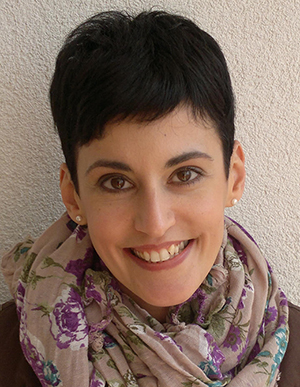
Mónika Mészáros
Teaching with Testimony in the 21st Century graduate Mónika Mészáros has published the first – and, likely, not the last – Hungarian teacher-authored IWitness activity.
Mészáros teaches History and Italian language at Berzsenyi Dániel High School in Budapest, a USC Shoah Foundation partner school. Her colleague Mónika Mezei completed USC Shoah Foundation’s professional development program Teaching with Testimony in the 21st Century, and in 2014 encouraged Mészáros to apply to the program as well.
Teaching with Testimony in the 21st Century, led by USC Shoah Foundation’s regional consultants in Europe, introduces teachers to the methodology and possibilities of teaching with testimony from the Visual History Archive. Teachers develop their own testimony-based classroom activities and lessons, pilot them in their classrooms, and return a year later to share their experiences with each other and the next year’s cohort.
Mészáros said the program deepened her understanding of the constructivist theory of learning, and gave her new ideas for connecting macro- and micro-history for her students.
“This is especially important for me as a History teacher but my experience is that students too are much more motivated by the “personal” aspect of history,” she said. “With the help of these stories it is easier to reach students, to get closer to them, to raise their empathy.”
She was also inspired by the interdisciplinary possibilities for using testimony in the classroom. Testimonies of genocide survivors are complex source materials that can help students develop their critical thinking skills, she noted.
Mészáros began developing what would ultimately become the first Hungarian teacher-authored IWitness activity, Hogy történhetett meg? (“How Could it Happen?”), in preparation for her class trip to the Auschwitz-Birkenau State Museum.
The first part of the activity (Construct) focuses on how the peaceful Polish town of Oswiecim became Auschwitz after the German occupation. This part also helps students get a clear understanding of the difference between Auschwitz and Birkenau. In the second part of the activity (Collect), Hungarian survivors speak about how the discriminatory laws were followed by the establishment of ghettos and how they were deported to Auschwitz where, despite the promises, no work awaited them. The task in the Construct part is to write a short essay based on the clips students watched. In this essay students reflect on why it is important to speak about the Holocaust even today. The short essay is a well-known genre for Hungarian students: it is a requirement at the final high school exams.
In the closing, teacher-led phase of the activity students learn about each other’s work and share their experiences about the process.
As she developed the activity, Mészáros used parts of it in her own class. When the activity was finally completed, students volunteered to pilot it at her school’s Tolerance Day. It was a big success, Mészáros said.
She is now working on an IWitness video activity on the role of art in the Holocaust and is starting to develop an Information Quest activity on the topic of national identity.
Throughout her work with testimony in her classroom, Mészáros has found that the stories of survivors have a huge impact on students.
“The complexity and multi-layered character of the testimonies offer enormous possibilities: students not only gain knowledge by learning new information, but they develop in a moral aspect as well,” Mészáros said. “Differentiating between fact and opinion helps students develop critical thinking and this new way of learning increases their motivation.”